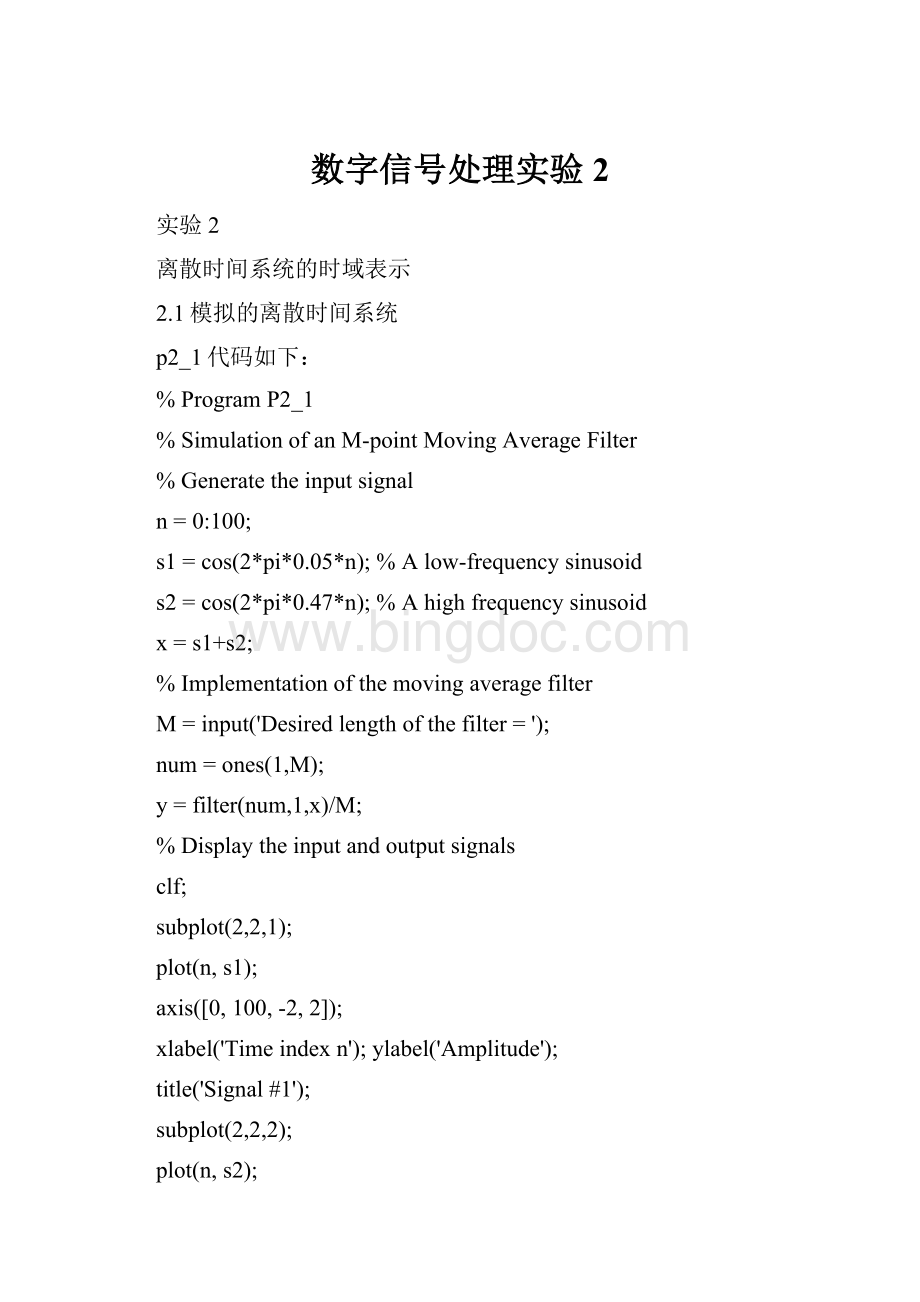数字信号处理实验2.docx
《数字信号处理实验2.docx》由会员分享,可在线阅读,更多相关《数字信号处理实验2.docx(40页珍藏版)》请在冰点文库上搜索。

数字信号处理实验2
实验2
离散时间系统的时域表示
2.1模拟的离散时间系统
p2_1代码如下:
%ProgramP2_1
%SimulationofanM-pointMovingAverageFilter
%Generatetheinputsignal
n=0:
100;
s1=cos(2*pi*0.05*n);%Alow-frequencysinusoid
s2=cos(2*pi*0.47*n);%Ahighfrequencysinusoid
x=s1+s2;
%Implementationofthemovingaveragefilter
M=input('Desiredlengthofthefilter=');
num=ones(1,M);
y=filter(num,1,x)/M;
%Displaytheinputandoutputsignals
clf;
subplot(2,2,1);
plot(n,s1);
axis([0,100,-2,2]);
xlabel('Timeindexn');ylabel('Amplitude');
title('Signal#1');
subplot(2,2,2);
plot(n,s2);
axis([0,100,-2,2]);
xlabel('Timeindexn');ylabel('Amplitude');
title('Signal#2');
subplot(2,2,3);
plot(n,x);
axis([0,100,-2,2]);
xlabel('Timeindexn');ylabel('Amplitude');
title('InputSignal');
subplot(2,2,4);
plot(n,y);
axis([0,100,-2,2]);
xlabel('Timeindexn');ylabel('Amplitude');
title('OutputSignal');
axis;
回答:
Q2.1令M=2,运行上述程序,生成输出信号。
输入x【n】的哪个分量被离散时间系统控制:
频率
Q2.2线性时不变系统改为y[n]=0.5(x[n]–x[n–1])对x[n]=s1[n]+s2[n]的影响:
造成的结果是-该系统现在是一个高通滤波器。
它通过高频率的输入分量S2,而不是低频分量输入S1。
Q2.3程序p2_1运行以下值滤波器长度m和以下的正弦信号S1[n]和S2[n]的频率¬频率值。
输出产生这些不同的m值和频率如下所示。
从这些图中我们提出以下意见–
f1=0.05;f2=0.47;M=15
Q2.4修改程序p2_1通过改变输入序列的扫频正弦信号(长度为101,最小频率为0,和最大频率0.5)作为输入信号(见程序p1_7)如下:
%ProgramP1_7
%Generationofasweptfrequencysinusoidalsequence
n=0:
100;
a=pi/2/100;
b=0;
arg=a*n.*n+b*n;
x=cos(arg);
%ProgramP2_1
%SimulationofanM-pointMovingAverageFilter
%Generatetheinputsignal
%Implementationofthemovingaveragefilter
M=input('Desiredlengthofthefilter=');
num=ones(1,M);
y=filter(num,1,x)/M;
%Displaytheinputandoutputsignals
clf;
subplot(2,2,1);
plot(n,s1);
axis([0,100,-2,2]);
xlabel('Timeindexn');ylabel('Amplitude');
title('Signal#1');
subplot(2,2,2);
plot(n,s2);
axis([0,100,-2,2]);
xlabel('Timeindexn');ylabel('Amplitude');
title('Signal#2');
subplot(2,2,3);
plot(n,x);
axis([0,100,-2,2]);
xlabel('Timeindexn');ylabel('Amplitude');
title('InputSignal');
subplot(2,2,4);
plot(n,y);
axis([0,100,-2,2]);
xlabel('Timeindexn');ylabel('Amplitude');
title('OutputSignal');
axis;
Theoutputsignalgeneratedbyrunningthisprogramisplottedbelow.
The从这个系统的扫频信号的响应问题q2.1和q2.2结果可以解释如下:
我们又看到,该系统是一个低通滤波器。
在图中的左,其输入是一个低频率的正弦曲线,通过对输出无衰减。
作为nincreases,输入的频率上升,增加的衰减是出现在输出。
在q2.1,输入的是一个两个正弦曲线的总和s1ands2withF1=0.05andF2=0.47。
扫频输入q2.4达到在n=10的频率为0.05,那里几乎没有衰减输出所示。
这种“解释“为什么s1was通过系统q2.1。
扫频输入q2.4大约在n=94的频率达到0.47,其中的衰减系统的充实。
这种“解释“为什么s2was几乎完全抑制在输出中q2.1。
没有直接的关系,结果表明上述q2.4和取得的结果有q2.2。
然而,使用频率域的概念(3章)我们可以推测,如果扫频信号输入到系统的[]=0.5(x的[][1]–X),我们会看到什么是如上所示相反的结果。
由于该系统将是一个高通滤波器,将有大量的输出衰减在图表的左边,几乎没有衰减在图表的右侧。
这种“解释“为什么inq2.2低频分量s1was抑制系统的输出,而高频分量s2was过去了。
Project2.3线性和非线性系统
P2_3代码如下:
%ProgramP2_3
%Generatetheinputsequences
clf;
n=0:
40;
a=2;b=-3;
x1=cos(2*pi*0.1*n);
x2=cos(2*pi*0.4*n);
x=a*x1+b*x2;
num=[2.24032.49082.2403];
den=[1-0.40.75];
ic=[00];%Setzeroinitialconditions
y1=filter(num,den,x1,ic);%Computetheoutputy1[n]
y2=filter(num,den,x2,ic);%Computetheoutputy2[n]
y=filter(num,den,x,ic);%Computetheoutputy[n]
yt=a*y1+b*y2;
d=y-yt;%Computethedifferenceoutputd[n]
%Plottheoutputsandthedifferencesignal
subplot(3,1,1)
stem(n,y);
ylabel('Amplitude');
title('OutputDuetoWeightedInput:
a\cdotx_{1}[n]+b\cdotx_{2}[n]');
subplot(3,1,2)
stem(n,yt);
ylabel('Amplitude');
title('WeightedOutput:
a\cdoty_{1}[n]+b\cdoty_{2}[n]');
subplot(3,1,3)
stem(n,d);
xlabel('Timeindexn');ylabel('Amplitude');
title('DifferenceSignal');
Answers:
Q2.7输出Y[N],加权得到的输入,和YT[N],OB¬获得由两个输出Y1和Y2的[][]具有相同的权重相结合,如下图所示随着两个信号之间的差异:
这两个序列–相同的数值舍入
系统是–线性的
Q2.8用三中不同的权系数以及三中不同的输入频率重做习题2.7
1.a=1;b=-1;f1=0.05;f2=0.4;
2.a=10;b=2;f1=0.10;f2=0.25;
3.a=2;b=10;f1=0.15;f2=0.20;
根据图片得出系统是–线性的
Q2.9改变2_3的初始条件-ic=[510];
图像如下-
我们可以得到非零初始条件的系统是–非线性
Q2.10当初始条件非零时重做习题2.8
1.a=1;b=-1;f1=0.05;f2=0.4;
2.a=10;b=2;f1=0.10;f2=0.25;
3.a=2;b=10;f1=0.15;f2=0.20;
根据图像可以得出非零初始条件的系统是–非线性
Q2.11将2_3的系统改为:
y[n]=x[n]x[n–1]
输出序列y1[n],y2[n],和y[n]的图像如下:
比较y[n]和yt[n]我们可以得到两个序列是–不一样的
系统是–非线性
Project2.4Time-invariantandTime-varyingSystems
AcopyofProgramP2_4isgivenbelow:
%ProgramP2_4
%Generatetheinputsequences
clf;
n=0:
40;D=10;a=3.0;b=-2;
x=a*cos(2*pi*0.1*n)+b*cos(2*pi*0.4*n);
xd=[zeros(1,D)x];
num=[2.24032.49082.2403];
den=[1-0.40.75];
ic=[00];%Setinitialconditions
%Computetheoutputy[n]
y=filter(num,den,x,ic);
%Computetheoutputyd[n]
yd=filter(num,den,xd,ic);
%Computethedifferenceoutputd[n]
d=y-yd(1+D:
41+D);
%Plottheoutputs
subplot(3,1,1)
stem(n,y);
ylabel('Amplitude');
title('Outputy[n]');grid;
subplot(3,1,2)
stem(n,yd(1:
41));
ylabel('Amplitude');
title(['OutputduetoDelayedInputx[n?
num2str(D),']']);grid;
subplot(3,1,3)
stem(n,d);
xlabel('Timeindexn');ylabel('Amplitude');
title('DifferenceSignal');grid;
Answers:
Q2.12Theoutputsequencesy[n]andyd[n-10]generatedbyrunningProgramP2_4areshownbelow-
Thesetwosequencesarerelatedasfollows-y[n-10]=yd[n]
系统是–时不变的
Q2.13采用不同的延时变量重做习题2.12
D=2
D=4
D=8
得到两个序列的关系是-y[n-D]=yd[n]
系统是–时不变
Q2.14采用3种不同的输入频率重做习题2.12
1.f1=0.05;f2=0.40;
2.f1=0.10;f2=0.25;
3.f1=0.15;f2=0.20;
我们可以得到两个序列-yd[n]不是经过y[n]经过以为得到的
系统是–时不变
Q2.15在非零的初始条件下重做习题2.14。
系统是–非时变
Q2.16在非零的初始条件下重做2.14
1.f1=0.05;f2=0.40;
2.f1=0.10;f2=0.25;
3.f1=0.15;f2=0.20;
这两个序列的关系是-yd[n]不是经过y[n]经过以为得到的
系统是–非时变
Q2.17将2_4的系统改成:
y[n]=nx[n]+x[n-1]
源代码为:
%ModificationofP2_4toimplementthesystem
%givenby(2.16).
%Generatetheinputsequences
clf;
n=0:
40;D=10;a=3.0;b=-2;
x=a*cos(2*pi*0.1*n)+b*cos(2*pi*0.4*n);
xd=[zeros(1,D)x];
nd=0:
length(xd)-1;
%Computetheoutputy[n]
y=(n.*x)+[0x(1:
40)];
%Computetheoutputyd[n]
yd=(nd.*xd)+[0xd(1:
length(xd)-1)];
%Computethedifferenceoutputd[n]
d=y-yd(1+D:
41+D);
%Plottheoutputs
subplot(3,1,1)
stem(n,y);
ylabel('Amplitude');
title('Outputy[n]');grid;
subplot(3,1,2)
stem(n,yd(1:
41));
ylabel('Amplitude');
title(['OutputduetoDelayedInputx[n-',num2str(D),']']);grid;
subplot(3,1,3)
stem(n,d);
xlabel('Timeindexn');ylabel('Amplitude');
title('DifferenceSignal');grid;
输出序列y[n]andyd[n-10]根据P2_4改编之后得到:
Thesetwosequencesarerelatedasfollows-
2.2线性离散时间系统
项目2.5系统的脉冲响应计算
P2_5的源代码:
%ProgramP2_5
%Computetheimpulseresponsey
clf;
N=40;
num=[2.24032.49082.2403];
den=[1-0.40.75];
y=impz(num,den,N);
%Plottheimpulseresponse
stem(y);
xlabel('Timeindexn');ylabel('Amplitude');
title('ImpulseResponse');grid;
Answers:
Q2.19运行2.5得到的图像:
Q2.20修改P2_5的程序产生因果线性时不变系统的冲击响应的前45个样本:
y[n]+0.71y[n-1]–0.46y[n-2]–0.62y[n-3]
=0.9x[n]–0.45x[n-1]+0.35x[n-2]+0.002x[n-3]
clf;
N=45;
num=[0.9-0.450.350.002];
den=[1.00.71-0.46-0.62];
y=impz(num,den,N);
%Plottheimpulseresponse
stem(y);
xlabel('Timeindexn');ylabel('Amplitude');
title('ImpulseResponse');grid;
Q2.21利用filter命令编写一个程序生成因果线性时不变系统的冲击响应并画出前40个样本:
%ProgramQ2_21
%Computetheimpulseresponsey
clf;
N=40;
num=[0.9-0.450.350.002];
den=[1.00.71-0.46-0.62];
%input:
unitpulse
x=[1zeros(1,N-1)];
%output
y=filter(num,den,x);
%Plottheimpulseresponse
%NOTE:
thetimeaxiswillbeWRONG;h[0]will
%beplottedatn=1;butthiswillagreewith
%theINCORRECTplottingthatwasalsodone
%byprogramP2_5.
stem(y);
xlabel('Timeindexn');ylabel('Amplitude');
title('ImpulseResponse');grid;
前40个样本结果如下:
和问题2.20比较,两个序列是-一样
Q2.22MATLAB程序生成和绘制一个LTI因果系统的阶跃响应是表示如下:
%ProgramQ2_22
%Computethestepresponses
clf;
N=40;
n=0:
N-1;
num=[2.24032.49082.2403];
den=[1.0-0.40.75];
%input:
unitstep
x=[ones(1,N)];
%output
y=filter(num,den,x);
%Plotthestepresponse
stem(n,y);
xlabel('Timeindexn');ylabel('Amplitude');
title('StepResponse');grid;
图像:
项目2.6LTI系统的级联
P2_6的源代码:
%ProgramP2_6
%CascadeRealization
clf;
x=[1zeros(1,40)];%Generatetheinput
n=0:
40;
%Coefficientsof4thordersystem
den=[11.62.281.3250.68];
num=[0.06-0.190.27-0.260.12];
%Computetheoutputof4thordersystem
y=filter(num,den,x);
%Coefficientsofthetwo2ndordersystems
num1=[0.3-0.20.4];den1=[10.90.8];
num2=[0.2-0.50.3];den2=[10.70.85];
%Outputy1[n]ofthefirststageinthecascade
y1=filter(num1,den1,x);
%Outputy2[n]ofthesecondstageinthecascade
y2=filter(num2,den2,y1);
%Differencebetweeny[n]andy2[n]
d=y-y2;
%Plotoutputanddifferencesignals
subplot(3,1,1);
stem(n,y);
ylabel('Amplitude');
title('Outputof4thorderRealization');grid;
subplot(3,1,2);
stem(n,y2)
ylabel('Amplitude');
title('OutputofCascadeRealization');grid;
subplot(3,1,3);
stem(n,d)
xlabel('Timeindexn');ylabel('Amplitude');
title('DifferenceSignal');grid;
回答:
Q2.23输出序列y[n],y2[n],不同信号d[n]根据P2_6:
y[n],y2[n]的关系是-他们是相同的数值舍入。
Q2.24将输入改成正弦序列重做2.23:
y[n]和y2[n]在这里的关系是-他们是相同的数值舍入。
Q2.25用任意的非零初始向量来重做习题2.23:
y[n]和y2[n]在这里的关系式-一样的
Q2.26修改程序2.6,将2个二阶系统顺序颠倒并零初始条件下重复此过程:
%ProgramQ2_26
%CascadeRealization
clf;
x=[1zeros(1,40)];%Generatetheinput
n=0:
40;
%Coefficientsof4thordersystem
den=[11.62.281.3250.68];
num=[0.06-0.190.27-0.260.12];
%Computetheoutputof4thordersystem
y=filter(num,den,x);
%Coefficientsofthetwo2ndordersystems
num1=[0.3-0.20.4];den1=[10.90.8];
num2=[0.2-0.50.3];den2=[10.7